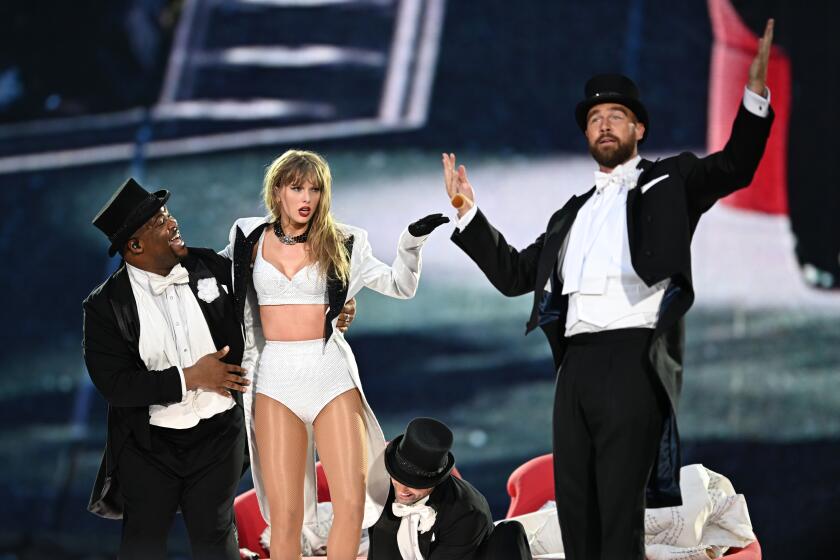POP MUSIC : The Rhythm ‘n’ Blues Brothers : Jimmy Jam and Terry Lewis are in tune with L.A. and New York music scenes--but keep churning out their hits from Minnesota
In an unmarked blond-brick building in this suburb of Minneapolis, more R&B; and pop hits have been churned out than in any place else in the Midwest since the glory days of Motown.
Producer-writers Jimmy Jam and Terry Lewis over the last decade have accounted for 22 Top 10 pop songs (including seven No. 1 records) and 46 Top 10 R&B; hits (including 18 chart-toppers). They won a Grammy for producer of the year in 1987, and they have been named songwriters of the year by ASCAP, one of the two major U.S. song-licensing organizations, twice in the last four years.
Almost every Jam-Lewis hit record has been made at Flyte Tyme Studios in their hometown of Minneapolis, first in a small building in the ‘hood and more recently in their $3-million complex in the ‘burbs. Everyone from Herb Alpert and Janet Jackson (Jam and Lewis’ signature artist) to Human League and Color Me Badd has schlepped to Minneapolis to work with these consistently successful producers.
Jam and Lewis could have set up shop in Los Angeles, as they actually did for a few months in 1983 after Prince kicked them out of the Time, the hitmaking R&B; band he fathered, because they missed a concert (they were producing a project and got marooned in Atlanta by a snowstorm).
“We wouldn’t be as happy (in L.A.),” Jam said. “In a creative business, you should be where you create good. We create good in Minneapolis. That’s not to say we couldn’t do it good in New York or L.A. We like the lifestyle here; we’re comfortable here. It’s our home and we grew up here. We have friends and family here. That all adds up to a successful creative atmosphere.”
In Minnesota, Jam and Lewis are removed from the rest of the music industry, and therefore, Lewis said, they are “unaffected by what other people are doing. When you’re out there (in L.A.), people compare you to other things. Here we get compared to Prince; it’s a little smaller community. Out there, you get compared to everybody, which is not fair; there are so many wonderful artists.”
Jam and Lewis own and run five businesses from their 17,000-square-foot complex, which used to be a warehouse. They have a song-publishing firm, a record production company (with a staff of five in Hollywood), a film division and, of course, their songwriting and producing work.
Jam and Lewis have just released what may be their most important project since Jackson’s breakthrough “Control” album in 1986. The soundtrack to the forthcoming Damon Wayans movie “Mo’ Money” came out last week on Jam and Lewis’ Perspective Records. It features an all-star cast including Luther Vandross and Jackson on a duet (with a rap break by Bell Biv DeVoe), Color Me Badd, Public Enemy, MC Lyte, Big Daddy Kane and such familiar Jam-Lewis clients as Johnny Gill and Ralph Tresvant, as well the Perspective acts Sounds of Blackness, Mint Condition and Krush.
Like the Hollywood outsiders that they are, Jam and Lewis approached this project differently than other label executives or producers might have. Instead of going through label executives, managers and lawyers to arrange to work with artists on other labels, Jam and Lewis often went directly to the artists, recorded the songs and then left the occasionally acrimonious negotiations for permission to be done later.
“It was one of those projects (on which) you find out who your friends are,” said Jam, who, along with Lewis, has worked on projects for many labels. “Not only did we find out we had a lot of friends on the artist level who came through for us, but on the management level and record-company level.”
It also helps that Jam and Lewis have an outstanding track record. John McClain, Interscope Records vice president, who put Jam and Lewis together with Jackson when he was at A&M; Records, says that any of their singles “is like a Roger Penske car--it should be in the Top 5 of an Indy 500. Jimmy and Terry are respected. A lot of record companies want to do business with them, so they will naturally give them carte blanche just to develop a relationship.”
Even Virgin Records, which spirited Jackson away from A&M; for a princely sum, gave permission for her first recording since signing the deal to be a single on A&M-distributed; Perspective. Of course, it helps that Jam and Lewis are already signed to produce Jackson’s first album for Virgin.
Vandross asked Jam and Lewis to let him be on the soundtrack when Sounds of Blackness, a Perspective act from Minneapolis, was on tour opening for Vandross. He asked the producers to write a song that was not typical of the kind he records. Jam says neither Vandross nor Jackson knew they were going to be recording together until they arrived at the studio.
Epic Records, for which Vandross records, figured this was “a once-in-a-lifetime opportunity” for him, said an Epic spokesman.
For “Mo’ Money,” Jam and Lewis shared writing credits with each artist except Public Enemy, which wrote and produced its own number. For all other selections, the musical tracks were recorded in Edina with the vocals being cut in a two-week frenzy there and in New York and Los Angeles.
“We wrote the lyrics and the harmonies on the bus on tour,” Color Me Badd’s Sam Watters said of “Forever Love.” “We sang it to them. Jimmy Jam had the (rhythm) track laid down within an hour. Then the next day we recorded the whole song in one day with Terry Lewis engineering the whole thing.”
Jam, 33, and Lewis, 35, have never had a fight. They have never even signed an agreement, despite warnings from lawyers, that they split all revenues and credits equally regardless who writes or produces a song. Jam even insisted when he won an award from Keyboard magazine that Lewis’ name be added to the plaque, even though Jam is a keyboardist by trade and Lewis a bass player.
When receiving an award in Minneapolis a few years ago, Lewis said he would have married Jam if Jam were a woman. Is their relationship better than a good marriage?
“In a lot of ways you probably could say that, depending who the woman is,” said the twice-married Lewis, who last year wed singer Karyn White. “Better than my marriage now? No. It’s about the same.
“It’s not a common relationship,” Lewis said of his and Jam’s. “It’s not built on greed but built on trust; everything is 50-50.
“We share the same value system as human beings--respect one another, respect other people. We both have good work ethics. We know how to be a friend. We respect each other’s space and creative abilities.”
Said Susan Owens, their assistant for the last six years: “They listen to each other and talk about everything, and they come to conclusions together. They truly love each other.”
Jam and Lewis invariably show up wearing hats or baseball caps and usually matching sunglasses. Mostly, though, it’s a yin and yang partnership.
Jam likes romantic and jazzy music, Lewis likes hard funk. Jam is a “confirmed bachelor” with a steady girlfriend, Lewis is a family man with three children. Jam eats in gourmet restaurants, Lewis prefers joints that serve fried chicken or hamburgers. Jam sits courtside at every Minnesota Timberwolves basketball game, Lewis plays basketball every day and watches Timberwolves games on TV at home with his kids.
Jam is gregarious and does the PR, Lewis is private and business-oriented. Jam speaks in paragraphs, Lewis in sentences. Jam is more the artistic visionary, Lewis is more a details person who writes the lyrics.
“They’re very easygoing,” Owens said. “Terry is like everybody’s dad around here. Jimmy is like the big brother type.”
Lewis and James (Jimmy Jam) Harris III met at an extracurricular educational program in junior high school. Later Lewis, a state track champion, turned his attention to music after a football injury. Harris, the son of a jazz keyboardist, worked as a disco deejay. In the late 1970s, they hooked up in an R&B; band called Flyte Tyme. In ‘81, Prince took Flyte Tyme under his wing and renamed it the Time. The group recorded a series of R&B; smashes, and Jam and Lewis, at the invitation of Los Angeles producer Leon Sylvers, started writing songs for other singers.
Their first assignment paid $1,500 for a song. Now it takes a fee of at least $1 million plus royalties to get Jam and Lewis to produce and write an entire album.
Jam’s day usually begins at 10 a.m. He showers, eats breakfast and watches “The Young and the Restless.” Then it’s into the office to deal with business. And, unless there’s a Timberwolves game, he spends most of the night in the studio. Going home early, he says, is 2 or 3 a.m.
Lewis’ typical day is to get up and take the children to school and then go back to sleep. From 11 a.m. to 1 p.m., he plays basketball at a YMCA. He goes to Flyte Tyme and showers and then deals with business details and phone calls, often until 5 a.m.
Why have Jam and Lewis been so successful?
It’s a combination of their musical breadth and depth, their innovation and their personalities.
“They’re well-rounded musically as far as the genres they can dip into,” Interscope’s McClain said. “They’re not dominated by their rhythmic or their chordal approach. They’re equal in all areas.”
No matter how you measure them, he said, they’re strong: harmonically and rhythmically, on mid-tempo and up-tempo songs as well as on ballads, with the economy of orchestrations and with lyrics and subject matter.
“Terry can write lyrics from a female perspective as well as from a male perspective,” McClain said. “Their production technique is probably the finest in the business. There are no holes in their armor.”
“They are one of the few production teams in America that really do practice the craft of producing,” said Jheryl Busby, Motown Records president. “There’s nothing about using a formula. Their sound has no limit, and it has no defined dimension to it. They map out a direction for each project.”
Lewis says it’s not about being the hottest or making the grandest recordings, but about being consistent. That’s why his and Jam’s approach is 50% art, 50% business. Lewis, who developed his business acumen as a youngster working odd jobs with his uncle, says that “without a healthy business practice, there is no room for creativity, because creativity is dwarfed because you’re so worried about how to pay the bills.”
“We never do something for money,” said Lewis, a multimillionaire. “We do it because creatively we feel we can contribute.”
Since neither Prince nor baseball hero Kirby Puckett hangs out much in public, Jimmy Jam is the Twin Cities’ most visible celebrity. At his Jack Nicholson seat at Timberwolves games, he will sign autographs until his pen runs dry.
“I don’t think of myself as a celebrity; that’s why I’m accessible and visible,” Jam said. “To me, a star is someone who you can’t touch and you can’t talk to. I never wanted to be like that. I love talking to people.”
Still, life is not perfect for Jam and Lewis in Minnesota. Some nights, or rather early mornings, when Jam might drop a client off at an Edina hotel in either his Bronco or Ferrari, he gets stopped by the police. Even though most of the local cops know these famous citizens, they are just not used to seeing blacks in Edina.
“It’s more annoying than anything else,” Jam said. “It’s never turned ugly. You grow up accepting that. I don’t take anything negative away from it. It’s unfortunately part of society. Overall, I think this is a beautiful state and a nice city. I’ve been here all my life. I like it 99% of the time. You can waste too much energy on the 1%.”
More to Read
The biggest entertainment stories
Get our big stories about Hollywood, film, television, music, arts, culture and more right in your inbox as soon as they publish.
You may occasionally receive promotional content from the Los Angeles Times.






